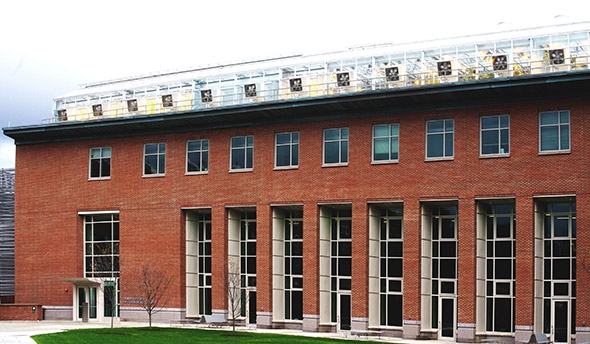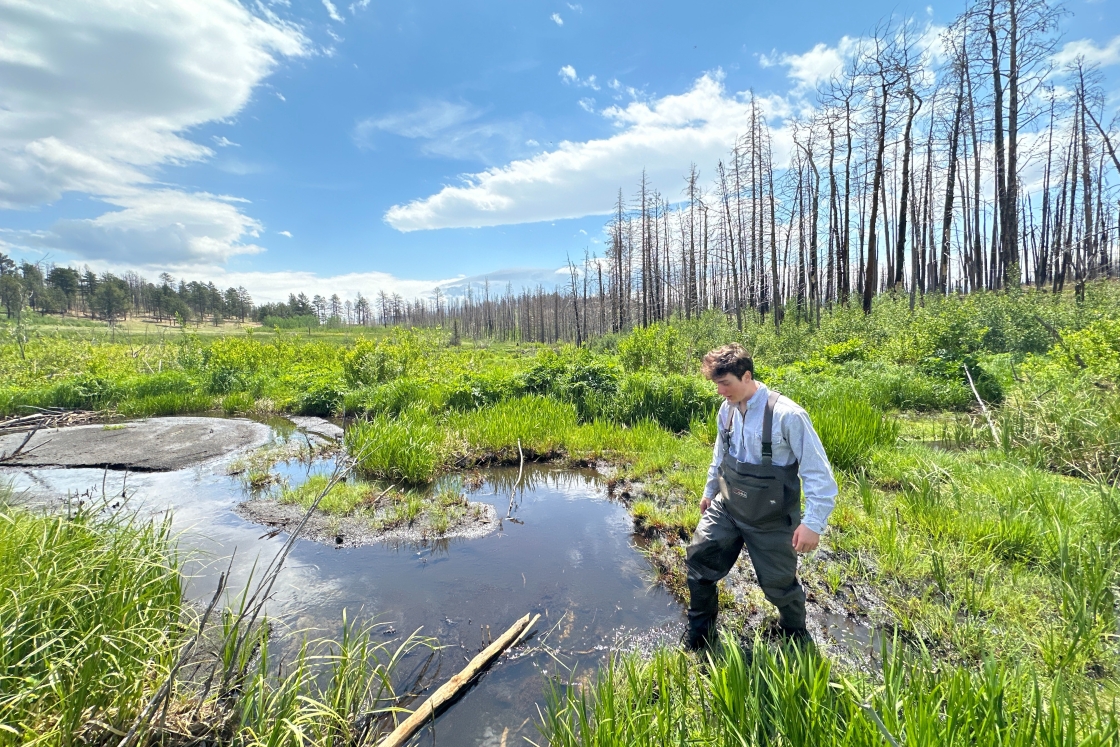Dartmouth’s 6,000-square-foot greenhouse sits atop the Class of 1978 Life Sciences Center like a crown of gleaming glass. This living botanical museum opened in August 2011, offering resources for research, serving as a classroom for budding botanists and veteran horticulturists, and providing an inviting space for casual visitors.

Half the greenhouse is for research and the rest is open to the public. “We have tours that cater to preschoolers through high school, as well as adult garden club members,” says Greenhouse Manager Kim DeLong. Greenhouse assistant Terry Barry carries some of this load in addition to the care and feeding of all the green inhabitants.
Climate-controlled rooms, geared to specific environments, house unique collections that are open to the public. Two rooms, one warm and one cool, house the award-winning Brout Orchid Collection, the gift of Alan Brout ’51. He donated nearly 1,000 individual plants and continues to find new and unusual orchids to add to the collection.
The tropical room includes plants that grow in areas where temperatures range from 65 degrees Fahrenheit (F) through the 80s. This collection includes banana, coffee, chocolate, and pineapple plants. Also present are about 30 species of carnivorous plants, a perennial favorite among younger visitors. However, DeLong recalls the negative reaction of one 3-year-old boy. “He just stopped in the doorway, terrified. He thought he was going to be eaten,” she says, but an explanation calmed his fears.
A sub-tropical room features a large fern collection along with a number of fragrant jasmine, olive, and pomegranate plants. There is also a pond with goldfish and aquatic plants. Sub-tropical plants can handle nighttime temperatures to around 45 degrees F.
A dry room offers a desert collection of plants in the cactus family, as well as other varieties that tolerate dry conditions, like some lilies, milkweeds, and some poinsettias.

Students often study in the multipurpose room, and many people use it for meetings or a place to eat lunch. DeLong says the tables are often full at lunchtime, but she recounts one unappetizing occurrence. “Our corpse flower just bloomed,” she says. ”We had to move it because it interfered with people’s lunches.” The mammoth Indonesian specimen exudes an odor similar to that of a decomposing animal.
DeLong explains that research greenhouses are built to different standards than wholesale nursery greenhouses. “We need to be able to control the intensity and duration of light or shade, as well as the temperature and humidity,” she says. “The conditions are controlled and monitored by computer.”
The research areas, closed to the public, are filled with experimental projects of Dartmouth faculty and their students. Professors Mary Lou Guerinot and Eric Schaller are both using the greenhouse to grow rice, a staple food for more than half the world.
Guerinot is growing rice that is transgenic—rice into which other genetic material has been introduced. “We are trying to figure out how plants take up and store metals, both beneficial metals like iron and zinc and detrimental ones like cadmium and arsenic. We use the transgenic rice lines to test various strategies to either increase or decrease the concentration of various metals in the rice grain,” she explains.
Schaller is investigating how the natural plant hormone cytokinin might be regulating grain yield in rice. “We use some of the growth chambers in the basement for rice, but rice takes up a lot of space, so we put an effort into getting one of the greenhouse rooms really set up for rice—and even now it is full,” says Schaller. “Also, rice likes lots of light so there we have the natural light from out of doors as well as supplemental lighting.”
Professor C. Robertson (Rob) McClung, like Schaller, uses both the growth chambers and the greenhouse. McClung studies the plant circadian clock—how a plant keeps time and uses that time information to regulate its biology.
“My current work investigates how the circadian clock intersects with plant resistance to stress in the crop species Brassica rapa (field mustard),” he says. Brassica is demanding, often requiring a great deal of light. “The enhanced growth facilities in the greenhouse are essential for us to continue cutting-edge research in plant biology in this new century.”
Professor Rebecca Irwin also uses the greenhouse for research. She is currently growing a vine native to the Southeast—Carolina Jessamine. “I have propagated the plant from collections made in multiple urban and wild sites in and outside of Raleigh/Durham, N.C. The goal of the project is to assess how urbanization affects plant-insect interactions and patterns of natural selection on floral and defensive traits,” says Irwin. In addition to using the greenhouse to grow plants in a common environment to measure traits, “The greenhouse also provides an excellent teaching resource for the class I teach in Plant Biology every other spring term,” she says.
